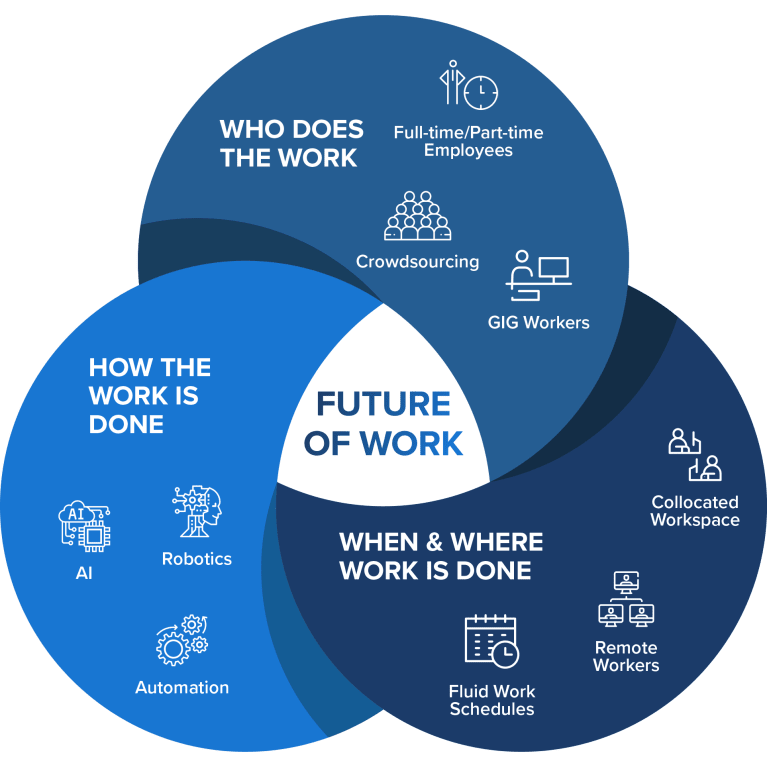Edition: December 28th, 2021
Curated by the Knowledge Team of ICS Career GPS

- Excerpts from article by Bernard Marr, published on Forbes.com
Much has been written about the huge changes in our working lives during the past two years – driven of course by necessity and concerns for safety. In 2022, the pandemic is very much still a fact of life. However, we’ve learned to adapt to new behavioural patterns and expectations as we do our jobs.
There are millions of knowledge workers who find themselves with more freedom to choose when and where they work. Consequently, they have the opportunity to strike a better balance between their home and work life.
However, there are many occupations and professions where this simply isn’t an option – E.g. frontline workers in healthcare, retail, teaching, transport, and security – among many other industries. In such cases, terms like ‘hybrid workplace’ probably have very little impact on their day-to-day lives. But they too are unlikely to remain untouched by digitalisation trends, as tech opens up opportunities for new ways of working and continues to redefine the relationship between us and our workplaces.
Here are the 5 biggest workplace trends that will define the future of work:
1. Hybrid Working
- When it comes to where we work, there will continue to be three main models – centralised workplaces, decentralised remote organisations, and the hybrid approach.
- In 2022, it is likely that workers will continue to have the power to choose one of these models – rather than being forced to align with a fixed one.
- Organisations are clearly undergoing a change in their relationship with the idea of a centralised workplace.
- Hybrid structures will range from companies maintaining permanent centralised offices with hot-desking to accommodate the fact that staff will more frequently work remotely, to doing away with offices entirely and relying on co-working spaces and serviced meeting rooms to support the needs of a primarily remote workforce.
- A report found that 90% of employees surveyed are happier with the increased freedom they now have to work from home, suggesting that this is likely to be a trend that is here to stay.
2. AI-augmented Workforce
- The World Economic Forum predicts that AI and automation will lead to the creation of 97 million new jobs by 2025.
- However, people working in many existing jobs will also find their roles changing. They will increasingly be expected to augment their abilities.
- Initially, AI will primarily be used to automate repetitive elements of workers’ day-to-day roles, allowing more minds to focus on areas that require the human touch – like creativity, imagination, high-level strategy or emotional intelligence.
3. Staffing for Resilience
- Pre-pandemic, the priority was to hire staff that would help create efficient organisations. Mid and post-pandemic, the emphasis has shifted firmly in the direction of resilience.
- Whereas built-in redundancy or overlaps in skills might previously have been seen as inefficient, today, it’s seen as a sensible precaution.
- This certainly encompasses another sub-trend, which is that employers are coming to understand the critical importance of building employee healthcare and wellbeing (including mental health) strategies into their game plan.
- Many employers are now trying to take more responsibility for helping their workforce maintain physical, mental and financial wellbeing.
- Ensuring that a workforce is healthy enough to keep a business running is clearly a critical element of resilience, but it also covers the implementation of processes that are more flexible to provide cover when disaster strikes.
- These processes are sure to play an increasingly big part in the day-to-day lives of workers as we move through 2022.
4. More Focus on Skills vis-à-vis Roles
- Employers are also beginning to focus less on roles and more on skills to drive their organisation’s competitive advantage.
- Skills are critical because they address core business challenges.
- Roles, on the other hand, describe the way individual members of a workforce relate to an overall organisational structure or hierarchy.
- We’ve certainly seen this trend gestating for some time, with the move towards more “flat” organisational structures as opposed to strictly hierarchical teams with a direct reporting, chain-of-command approach to communication and problem-solving.
- By focusing on skills, businesses address the fact that solving problems and answering their core business questions is the key to driving innovation and success within information-age enterprises.
- From the worker’s point of view, focusing on developing their skills equips them better to capitalise on new career opportunities.
- This shift in focus from roles to skills is likely to be a key trend for both organisations and workers in 2022 and beyond.
5. Employee Monitoring & Analytics
- Controversial though it may be, research shows that employers are increasingly investing in technology designed to monitor and track the behaviour of their employees in order to drive efficiency.
- Platforms that allow businesses to monitor behaviour across email and tools in order to measure productivity are being seen as particularly useful by managers overseeing remote workforces.
- However, caution is recommended as it would be easy for companies to use these tools in a way that would be seen as overbearing or intrusive by their workers.
- The idea should be to use them to gain broad oversights into workforce behaviour rather than focus on any individual’s activity for enforcing discipline.
- For better or worse, it seems likely that this kind of technology will play an increasingly large role in the workplace during 2022.
….
Education & Career Trends: 5 Tips for Impactful CV Layout and Structure
(Disclaimer: The opinions expressed in the article mentioned above are those of the author(s). They do not purport to reflect the opinions or views of ICS Career GPS or its staff.)
Like this post? For more such helpful articles, click on the button below and subscribe FREE to our blog.





One Reply to “Career Trends: The 5 Biggest Workplace Trends in 2022 & Beyond”